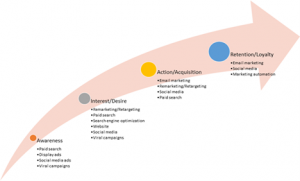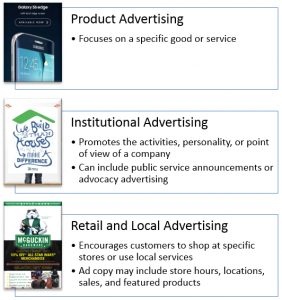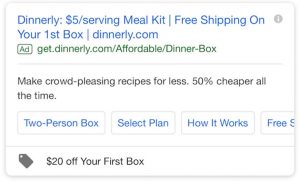Module 2: Readings and Videos Part II

Overview
Search engine marketing refers to how well you rank on a Google search engine results page (SERP) regardless of whether your results are paid or unpaid (organic). Last learning outcome, you studied how to build a stronger ranking for organic search results based on search engine optimization. This learning outcome, you will learn about paid search advertising, how Google ranks paid advertisements, and what to take into account while developing a paid search campaign.
In addition to paid search, you will also learn about display advertising, how it differs from search advertising, and how to use it effectively.
Module Objectives
Upon completion of this part of the module, you should be able to:
- Identify the various types of search engine advertisements and their parts.
- Analyze the effectiveness of an existing search engine advertising campaign and determine ways to improve an ad’s position without increasing the bid amount.
- Create a categorized list of keywords on which to advertise on a search engine.
- Describe the role of publishers and advertisers in an ad network.
- Explain the difference between CPC, CPM, and CPA bidding strategies.
- Identify target audiences for advertising using the Google Ads platform.
- Create a test to determine which of two slightly different ads is more effective.
While improving your SEO will drive people to your website, it takes time to grow. In the meantime, advertising is often an excellent way to find your audience, share your message, and invite them to learn more about you.
What Is Advertising?
Advertising is an important part of building awareness with a target market. Take a look at the image below that describes the hierarchy of effects. The steps to building and growing relationships with customers or clients include building awareness, sparking an interest or desire, prompting an action or purchase, and growing loyalty. Advertising starts in that first category of building awareness. It allows you to reach a broad base of your target market to build awareness of your brand or product/service.

There are multiple types of advertising, as illustrated in the graphic below. Each of these types of advertising accomplishes a different goal or objective for the business doing the advertising.

The point of advertising is to get your message to the right audience at the right time for the lowest possible cost and highest possible return. To do this, you have to make several decisions, such as:
- Who are you talking to?
- What message do you want to convey?
- Where do you advertise to reach your audience?
- How will you measure success?
Creating a Successful Online Advertising Campaign
The very first, and arguably most important step, in creating an advertising campaign is knowing your target market.
Step 1 in a successful advertising campaign is to know your target market. Not just their demographics but also their habits and interests. What do they read? What do they watch? What do they do for fun? What social media platforms do they participate in? Getting inside your consumer’s head lets you truly understand how your product fits into their lives. How does it provide value versus what are their needs?
Once you understand your target market, Step 2 is to establish your marketing message and budget. What exactly is it that you’re trying to communicate to your audience? Are you building general awareness? Selling a specific product or service? Sharing a message about your company’s brand?
After you choose a budget and message, Step 3 is to create the advertisement. This is where the creative process comes into play and where concepts turn into advertisements. This is also where you translate your marketing message into customer appeal. What is the central idea of the ad, and how do you communicate that so your audience is receptive?
Step 4 in the process of developing a successful advertising campaign is to pretest what the ads will say. Pretesting is a research method that seeks to minimize mistakes by getting consumer reactions to ad messages before they appear in the media. You may have already have had some exposure to this type of research. Occasionally, you’ll see people at the mall or movie theater offering to pay a small amount to give feedback on a movie trailer or series of advertisements. They are attempting to gauge the response of their target market before they finalize and make the ad public.
After you’ve researched your ad to see if your audience is open to your message and how you’ve conveyed it, Step 5 is to choose the media type(s) you will use to get that advertisement in front of your audience. This is where online methods differ from traditional methods of advertising. There are several different options when considering online advertising, which we will describe further in the next sections.
Step 6 is to evaluate the success of advertising. This includes some post-testing, which is research on your customers’ or clients’ responses to your advertising. Do they remember the brand or product in the advertisement without assistance? Do they remember it with assistance? What changes are there in attitude as a result of the advertising? Some of these metrics can be hard to measure. Social media polls, online surveys, and customer feedback emails and phone calls are some possible methods to measure your results.
Advertising on Digital Platforms
There are several ways you can use digital platforms to advertise your business, as described below.
Types of Ads
| Banners: These advertisements are typically displayed at the top of a website and span the full length of the page. |
| Popup Ads: Popup ads used to be advertisements that opened in another browser window or tab when you went to a certain website. The modern version of this is an add that appears on top of the content you are looking at that you have to specifically close. These ads often are not blocked by popup blockers. |
| Search Engine Ads: These ads appear at the top of the page (and sometimes on the sides) of your results when you look something up on a search engine. Common search engines to display ads include |
| Social Media Ads: Social media ads can run on Facebook, Twitter, LinkedIn, Pinterest, Tumblr, Reddit, and other social networking platforms. Often can be tailored more specifically to web activities, behaviors, nad demographics than other types of online advertising |
| YouTube Ads: Advertisements on YouTube come in the form of short video advertisements that come up before you play a video you’ve searched for. Though these ads are typically not long, you often have the option of choosing “Skip Ad” shortly into the advertisement. |
| In-app ads: In-app ads are advertisements that appear in applications, either web or mobile, during use of the app, during pauses in use of the app, or before use of the app. |
| In-game ads: In-game ads are either integrated into the game (as product placement, for example) or an ad that shows up during pauses in the game or between games. In-game ads different from advergaming, which is creating a game specifically for the purpose of advertising. |
| Website ads: These are ads that appear anywhere on a website, other than a banner ad. Examples could be smaller advertisements on specific pages of a website or on the sides. |
The buying and selling of advertising has changed over the years, particularly as it relates to digital advertising, The following video explains demand-side advertising and gives a bit of insight into how that has impacted marketing. Advertising today is responsive, quick, and effective in ways advertising never has been before.
Clear Ads is an advertising agency in London that offers free advice via YouTube on how to use Google Adwords, and in this case the Amazon Demand-Side platform.
Amazon Demand Side Platform from the inside. Amazon DSP and its powerful features.
Paid Search Advertising
The first type of online advertising we will cover is paid search. Some companies find paid search more beneficial, from a time- and cost-benefit perspective, than search engine optimization because it allows Google to do some of the work rather than having dedicated SEO staff or hiring an SEO company to monitor constantly changing algorithms. Search advertising, on Google or YouTube, for example, enables a company to advertise directly to a user who is already seeking out the services or products a company sells.
Ad Copy
When creating ad copy for an advertisement on Google, there are key elements to consider. The first is what keywords or keyword phrases your audience will be searching for. You will want to include those keywords or keyword phrases in your ad copy. You will also want to create an enticing and/or unique value proposition (How to Create a Unique Value Proposition (with Examples)) and a call to action (Hook, Line, and Sinker: 7 Tips for a Killer Call-to-Action).
Ad Extensions
Ad extensions enable you to add specific functionality to your Google ads, such as a call button or reviews. Some ad extensions Google offers include location (now automatically included), callout text, affiliate location, call, site link, structured snippets, price, app links, and reviews. The following blogs and articles provide more detailed information for your perusal:
- Google Ads Help, “About Google Ad Extensions” – (https://support.google.com/google-ads/answer/7331111)

[Source: https://instapage.com/blog/how-ads-extensions-generate-sales] - Google Ads Help, “Select Extensions to Use” – (https://support.google.com/google-ads/answer/7332837)
- The Wordstream Blog (Online advertising made easy), “Google Ad Extensions Cheat Sheet,” by Erin Sagin – (https://www.wordstream.com/blog/ws/2013/06/03/adwords-ad-extensions-cheat-sheet)
- PracticalEcommerce, “Google Ads Now Includes Location Extensions Automatically,” by Robert Brady – (https://www.practicalecommerce.com/google-ads-now-includes-location-extensions-automatically)
- AdEspresso by Hootsuite, “The Ultimate Guide to Google Ads Ad Extensions,” by Brad Smith – (https://adespresso.com/blog/guide-google-ads-ad-extensions/)
Google Adwords Quality Score
Display Advertising
In addition to paid search, online advertising also includes display advertising. You likely see display advertising in some form every day, unless your popup blockers are very efficient. Display ads may be banner ads at the top of a website, or they may take the form of ads you see between paragraphs in the Buzzfeed article you’re reading. Regardless, display ads use a different approach from search ads.

With display ads, your audience is not seeking you out, which means you have to first catch their attention. To make a display ad effective, the consumer must see the ad, process the ad, decide to investigate, and convert. In many ways, those first two steps are the hardest. We, as consumers, see so many advertisements every day that we tend to tune them out. Often, we’ll skim websites with multiple ads and not notice a single one.
So how does a company manage to catch someone’s attention if the viewer is actively avoiding seeing ads? To prevent nonresponse, a company must advertise on reputable ad networks that only record impressions when an ad loads on a page or appears on a browser and when a user is a real person rather than a bot. The ad must be unconsciously readable, which means a viewer must be able to understand the ad without actually paying attention to it. This is often accomplished through graphics and strategically placed simple text. The message must be optimized with a targeted offer and call to action. And, lastly, the ad must link to a landing page specifically designed to match the message and appearance of the ad.
Landing pages designed for a specific ad campaign enable a company to measure traffic and conversion for just that ad campaign. There are three key elements that should stay consistent when considering ads and their related landing pages:
- Tout the same value propositions.
- Use similar calls to action.
- Enact the same design elements (color scheme, characters, fonts, imagery, etc.)

